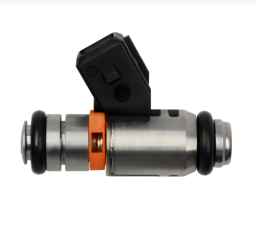- Injector
Now the fuel injection nozzle for automobile is actually a simple solenoid valve. When the solenoid coil is energized, suction is generated, the needle valve is sucked up, the nozzle hole is opened, and the fuel is ejected at high speed through the annular gap between the shaft needle and the nozzle hole at the head of the needle valve, forming a fog, which is conducive to full combustion. In the past, the fuel injection nozzle used in diesel engine was mechanically controlled. The mechanical diesel nozzle works by controlling precision coupling parts (needle valve and needle valve body). Nozzle coupling is one of the three precision coupling parts of traditional diesel engine. Gasoline engine nozzle is a part of gasoline engine electronic control system, which replaces the carburetor of carburetor gasoline engine. Automotive nozzles mainly include: diesel nozzle, gasoline nozzle, natural gas nozzle, etc.

As one of the key components of EFI engine, the fuel injection nozzle will affect the performance of the engine. Fuel injection nozzle blockage will seriously affect vehicle performance. The reason for the blockage is that the carbon in the engine is deposited on the fuel injection nozzle or the fuel impurities block the fuel injection nozzle passage. After the car has been running for a period of time, certain deposits will form in the fuel system. The formation of deposits is directly related to the fuel of vehicles: first, because the gasoline itself contains colloids and impurities, or the dust and impurities brought in during storage and transportation, deposits similar to oil sludge are formed in the fuel tank and oil inlet pipe of vehicles over time; Secondly, the unstable components in gasoline react at a certain temperature to form colloidal and resin like viscous substances. When these viscous substances burn in the fuel injection nozzle, intake valve and other parts, the sediment will become hard carbon deposit.
In addition, due to urban traffic congestion, cars are often at low speed and idle speed, which will aggravate the formation and accumulation of these sediments. Deposits in the fuel system are very harmful. The sediment will block the needle valve and valve hole of the fuel injection nozzle, affect the working performance of the precision components of the electronic injection system, and lead to carbon deposition in the intake valve under the dynamic performance, resulting in its lax closing, unstable engine idle speed, increased fuel consumption and deterioration of exhaust emission; Deposits will form hard carbon deposits on piston crown and cylinder head. Due to the high heat capacity and poor thermal conductivity of carbon deposits, it is easy to cause engine shock and other faults; In addition, it will shorten the service life of the three-way catalyst.
The work of fuel injection nozzle plays a fundamental role in the power of each engine. Poor fuel causes the fuel injection nozzle to work improperly, resulting in serious carbon deposition in the cylinder; The accelerated wear of cylinder barrel and piston ring will cause unstable idle speed, increased fuel consumption, weak acceleration, difficult starting and excessive emission. In serious cases, the fuel injection nozzle will be completely blocked and the engine will be damaged. Therefore, the fuel injection nozzle should be cleaned regularly. Long-term non cleaning or frequent cleaning of the nozzle will have a bad impact.
Troubleshooting of fuel injection nozzle
Nozzle hole blockage: it can be dredged with a through needle and carefully cleaned after dredging. Poor contact between the large plane of the needle valve body and the plane of the main body of the fuel injection nozzle, or large wear of the cylindrical surface of the needle valve. If the large plane of the needle valve body is in poor contact with the plane of the main body of the fuel injection nozzle, chromium oxide can be coated on the flat plate for "8" grinding; If the cylindrical surface of the needle valve is greatly worn, the needle valve coupling parts shall be replaced in pairs.
Poor sealing: poor sealing of needle valve and needle valve body, resulting in poor atomization or oil dripping of fuel injection nozzle.
For this fault, fine chromium oxide or toothpaste can be applied to the sealing belt at the needle valve end, but do not apply it to the cylindrical part. Then insert the needle valve into the needle valve body and turn it while knocking until it is closed. Chromium oxide or toothpaste must be washed off after grinding.
Air: there is air in the oil circuit. Just remove the air from the oil circuit.
Insufficient spring force: the spring force of the piston spring is insufficient or the spring is broken. Replace the spring. Poor oil supply: the oil transfer pump needs to be overhauled. If the oil pipe joint leaks, try to connect it well to prevent it from leaking. Piston wear: piston wear affects oil supply. The piston needs to be replaced.
- Previous article: What are the components of a hydraulic motor

 中文
中文 English
English Español
Español Français
Français






